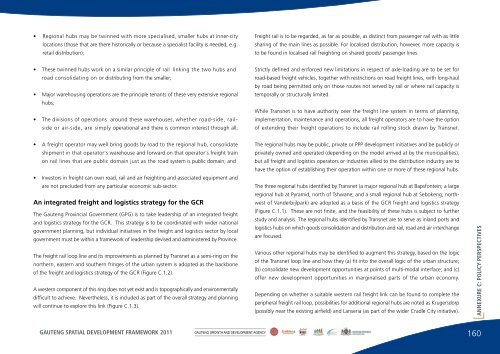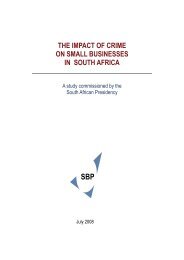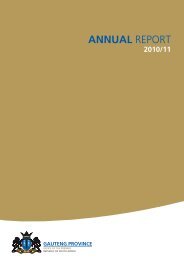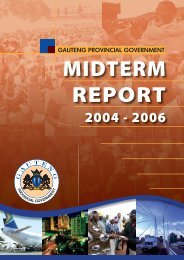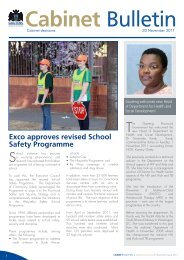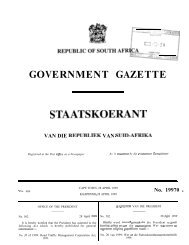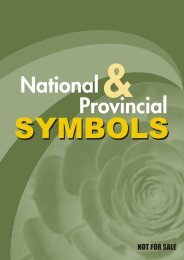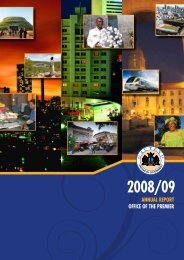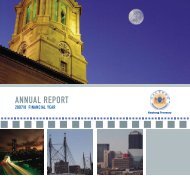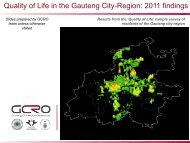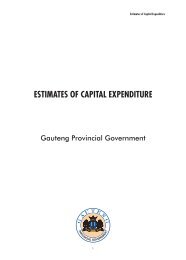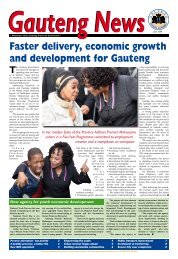the gauteng spatial development framework - Gauteng Online
the gauteng spatial development framework - Gauteng Online
the gauteng spatial development framework - Gauteng Online
Create successful ePaper yourself
Turn your PDF publications into a flip-book with our unique Google optimized e-Paper software.
• Regional hubs may be twinned with more specialised, smaller hubs at inner-citylocations (those that are <strong>the</strong>re historically or because a specialist facility is needed, e.g.retail distribution);Freight rail is to be regarded, as far as possible, as distinct from passenger rail with as littlesharing of <strong>the</strong> main lines as possible. For localised distribution, however, more capacity isto be found in localised rail freighting on shared goods/ passenger lines.• These twinned hubs work on a similar principle of rail linking <strong>the</strong> two hubs androad consolidating on or distributing from <strong>the</strong> smaller;• Major warehousing operations are <strong>the</strong> principle tenants of <strong>the</strong>se very extensive regionalhubs;• The divisions of operations around <strong>the</strong>se warehouses, whe<strong>the</strong>r road-side, railsideor air-side, are simply operational and <strong>the</strong>re is common interest through all;Strictly defined and enforced new limitations in respect of axle-loading are to be set forroad-based freight vehicles, toge<strong>the</strong>r with restrictions on road freight lines, with long-haulby road being permitted only on those routes not served by rail or where rail capacity istemporally or structurally limited.While Transnet is to have authority over <strong>the</strong> freight line system in terms of planning,implementation, maintenance and operations, all freight operators are to have <strong>the</strong> optionof extending <strong>the</strong>ir freight operations to include rail rolling stock drawn by Transnet.• A freight operator may well bring goods by road to <strong>the</strong> regional hub, consolidateshipment in that operator's warehouse and forward on that operator's freight trainon rail lines that are public domain just as <strong>the</strong> road system is public domain; and• Investors in freight can own road, rail and air freighting and associated equipment andare not precluded from any particular economic sub-sector.An integrated freight and logistics strategy for <strong>the</strong> GCRThe <strong>Gauteng</strong> Provincial Government (GPG) is to take leadership of an integrated freightand logistics strategy for <strong>the</strong> GCR. This strategy is to be coordinated with wider nationalgovernment planning, but individual initiatives in <strong>the</strong> freight and logistics sector by localgovernment must be within a <strong>framework</strong> of leadership devised and administered by Province.The freight rail loop line and its improvements as planned by Transnet as a semi-ring on <strong>the</strong>nor<strong>the</strong>rn, eastern and sou<strong>the</strong>rn fringes of <strong>the</strong> urban system is adopted as <strong>the</strong> backboneof <strong>the</strong> freight and logistics strategy of <strong>the</strong> GCR (Figure C.1.2).A western component of this ring does not yet exist and is topographically and environmentallydifficult to achieve. Never<strong>the</strong>less, it is included as part of <strong>the</strong> overall strategy and planningwill continue to explore this link (Figure C.1.3).The regional hubs may be public, private or PPP <strong>development</strong> initiatives and be publicly orprivately owned and operated (depending on <strong>the</strong> model arrived at by <strong>the</strong> municipalities),but all freight and logistics operators or industries allied to <strong>the</strong> distribution industry are tohave <strong>the</strong> option of establishing <strong>the</strong>ir operation within one or more of <strong>the</strong>se regional hubs.The three regional hubs identified by Transnet (a major regional hub at Bapsfontein; a largeregional hub at Pyramid, north of Tshwane; and a small regional hub at Sebokeng, northwestof Vanderbijlpark) are adopted as a basis of <strong>the</strong> GCR freight and logistics strategy(Figure C.1.1). These are not finite, and <strong>the</strong> feasibility of <strong>the</strong>se hubs is subject to fur<strong>the</strong>rstudy and analysis. The regional hubs identified by Transnet are to serve as inland ports andlogistics hubs on which goods consolidation and distribution and rail, road and air interchangeare focused.Various o<strong>the</strong>r regional hubs may be identified to augment this strategy, based on <strong>the</strong> logicof <strong>the</strong> Transnet loop line and how <strong>the</strong>y (a) fit into <strong>the</strong> overall logic of <strong>the</strong> urban structure;(b) consolidate new <strong>development</strong> opportunities at points of multi-modal interface; and (c)offer new <strong>development</strong> opportunities in marginalised parts of <strong>the</strong> urban economy.Depending on whe<strong>the</strong>r a suitable western rail freight link can be found to complete <strong>the</strong>peripheral freight rail loop, possibilities for additional regional hubs are noted as Krugersdorp(possibly near <strong>the</strong> existing airfield) and Lanseria (as part of <strong>the</strong> wider Cradle City initiative).ANNEXURE C: POLICY PERSPECTIVESGAUTENG SPATIAL DEVELOPMENT FRAMEWORK 2011GAUTENG GROWTH AND DEVELOPMENT AGENCY160


